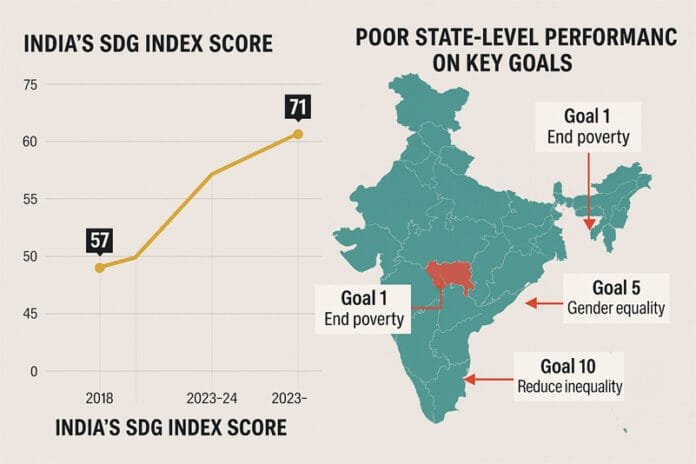India has climbed from 57 to 71 points on the UN Sustainable Development Goals (SDG) Index between 2018 and 2023–24, signaling significant progress on key global targets like poverty reduction, education, and institutional reform. But a deeper look at the state-level data reveals a more nuanced picture.
States Compete, But Not All Win
Kerala and Uttarakhand are leading, scoring over 80% in eight goals each. Close behind are Andhra Pradesh, Karnataka, Tamil Nadu, Telangana, and West Bengal, each with six goals scoring above the 80% mark. Notably, Punjab and West Bengal have shown consistent progress across all SDGs.
However, the data also uncovers backslides. Over nine states recorded a decline in scores for crucial goals such as:
Goal 1: End poverty
Goal 5: Gender equality
Goal 10: Reduce inequality
Goal 16: Peace, justice and strong institutions
In six specific goals, some states saw a drop of over 2%—a clear warning sign.
Does More Spending Mean More Progress?
The assumption is simple: more budget equals better outcomes. But reality tells a different story.
Some states—like Haryana, Odisha, and Meghalaya—have been transparent about SDG-related spending in their budgets. Yet, Odisha still lags on Goal 4 (quality education) and Goal 10 (inequality reduction). Meghalaya falters in both Goal 1 (poverty) and Goal 4 (education) despite reporting allocations. Haryana is behind on Goal 16 (institutions).
The question remains: are we measuring the right indicators or failing to deliver effective interventions?
What’s Missing? Reliable Data, Deeper Insights
Experts argue that spending may take time to show results. But consistent score drops suggest deeper structural issues. Without reliable, timely, and localized data, tracking SDG progress remains speculative.
More importantly, the interplay between SDGs—how one goal influences another—may be underestimated. Better modelling and data analysis could ensure smarter investments with compounded benefits.
















